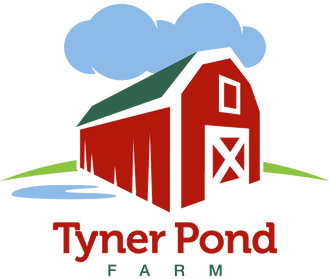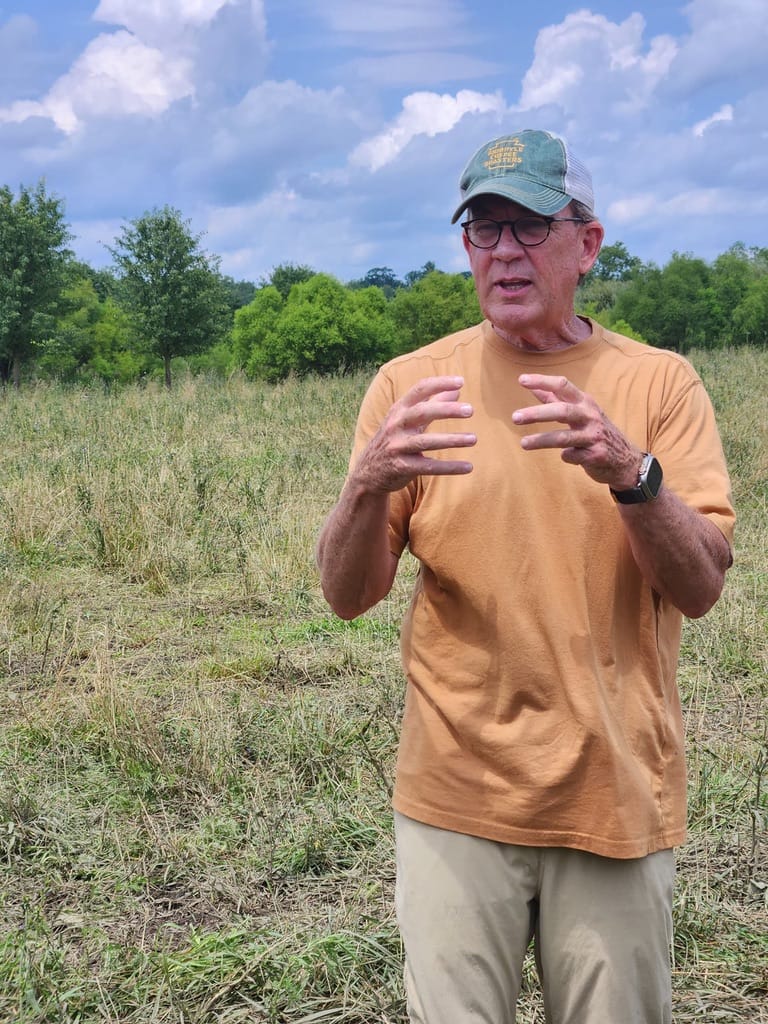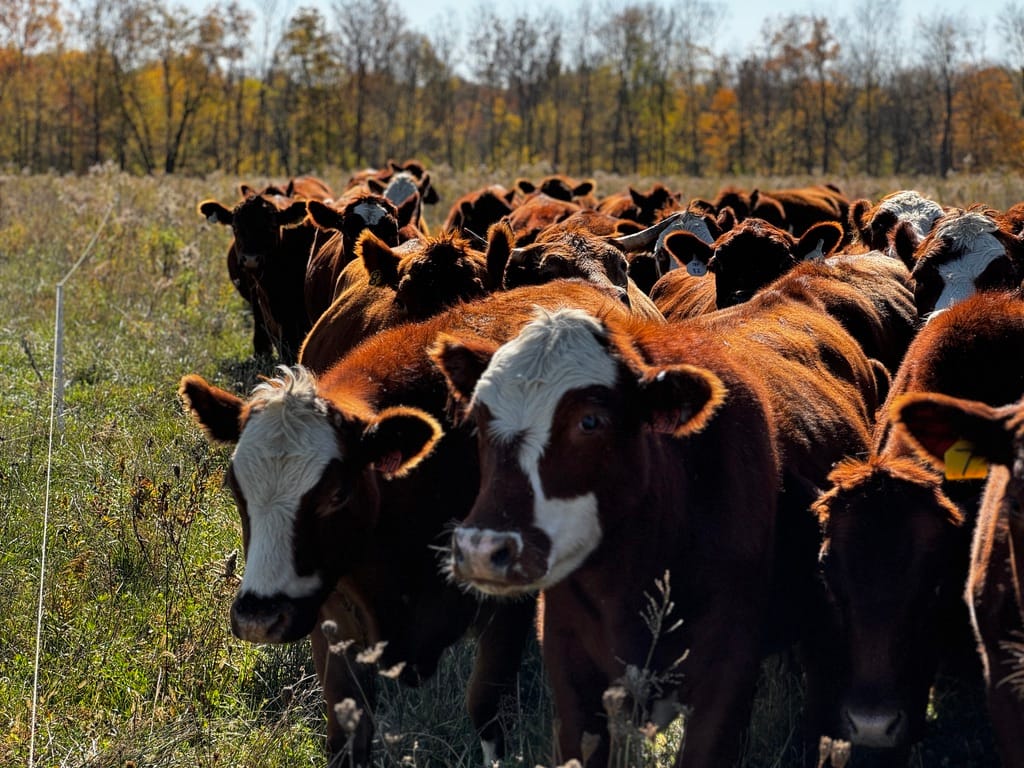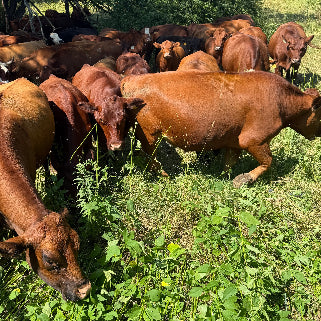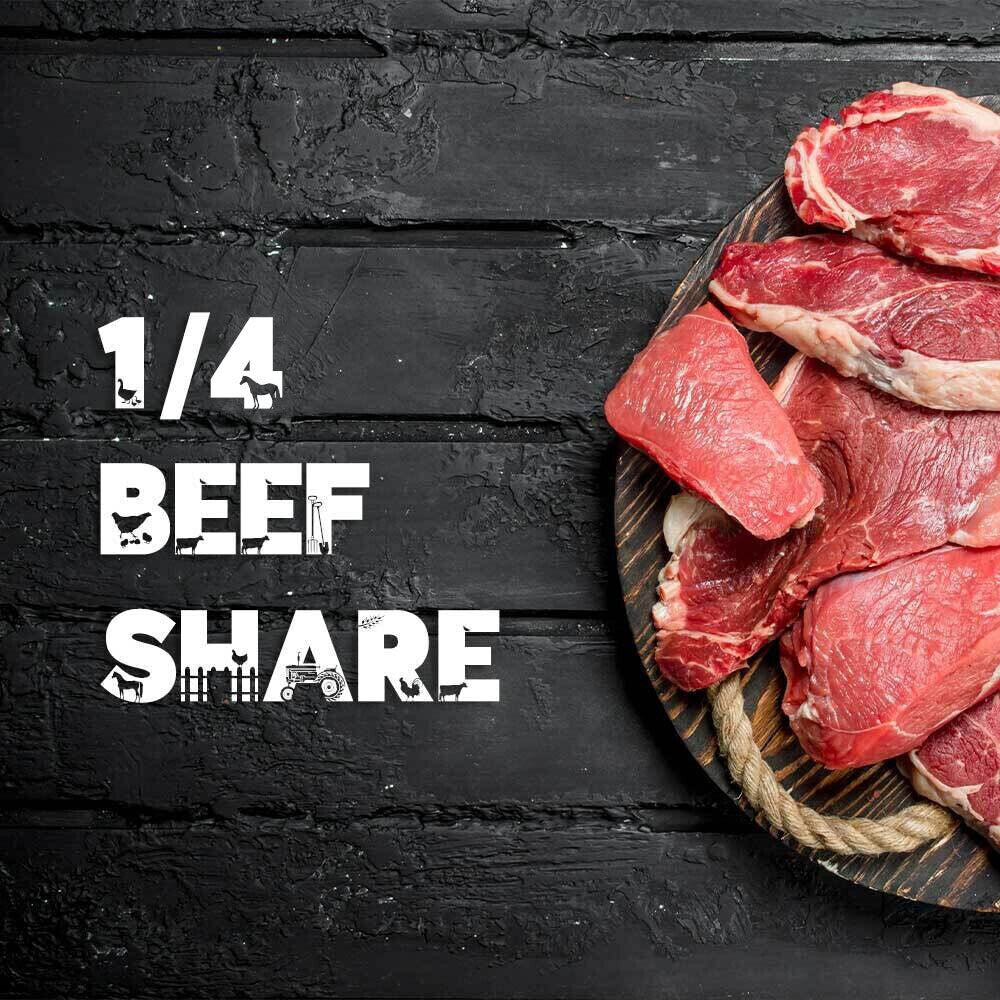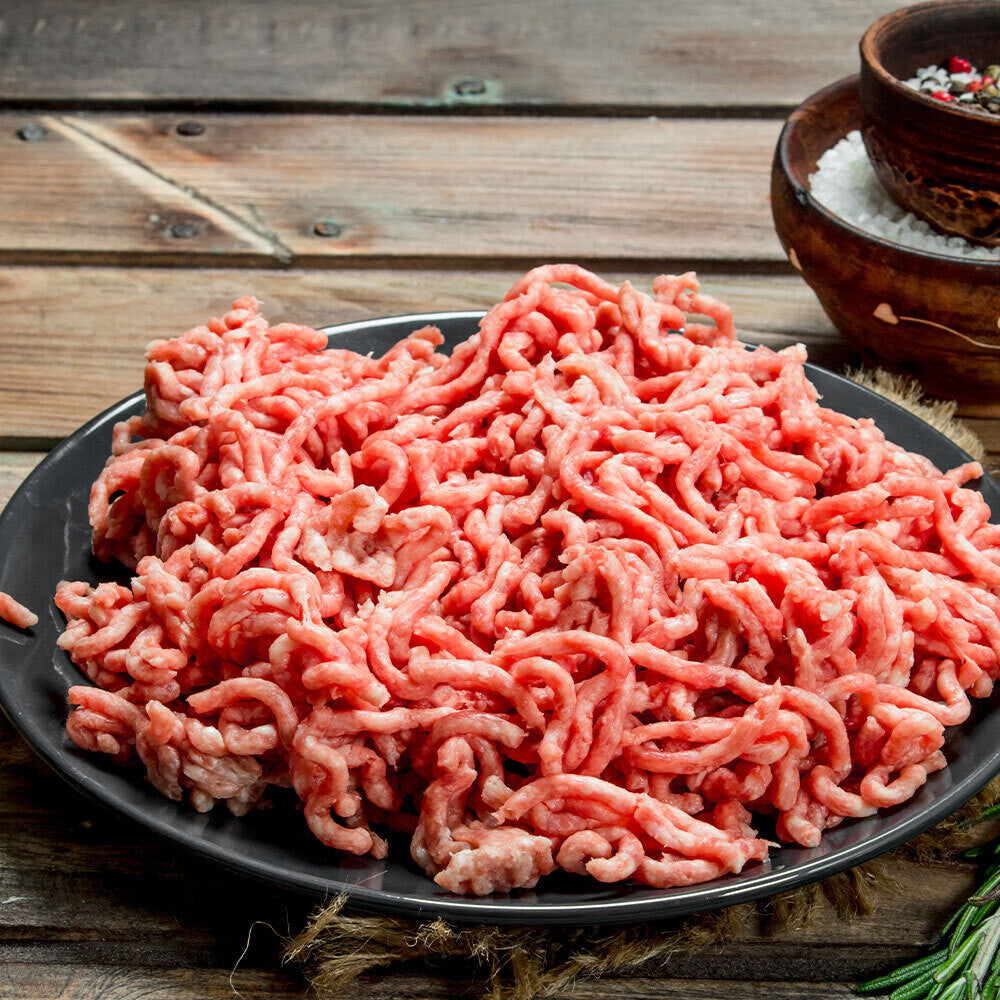
Regenerative Cattle Farming: Embracing Practices that Mitigate Methane and Carbon Emissions
In recent years, the environmental impact of cattle farming has become a hot topic, often vilified for its perceived contribution to climate change through the production of greenhouse gases like methane and carbon dioxide. However, not all cattle farming practices are created equal. In fact, certain holistic and regenerative farming methods not only reduce these emissions, but they also enhance soil health and biodiversity.
 Colony of bacteria
Let's start by introducing an unsung hero in our fight against cattle methane: methanotrophs. These unique bacteria thrive in soil and consume methane, a potent greenhouse gas. They require specific conditions, including access to oxygen and methane, suitable temperature, and a balanced pH level. Healthy, diverse soil ecosystems are ideal environments for methanotrophs to prosper.
Colony of bacteria
Let's start by introducing an unsung hero in our fight against cattle methane: methanotrophs. These unique bacteria thrive in soil and consume methane, a potent greenhouse gas. They require specific conditions, including access to oxygen and methane, suitable temperature, and a balanced pH level. Healthy, diverse soil ecosystems are ideal environments for methanotrophs to prosper.
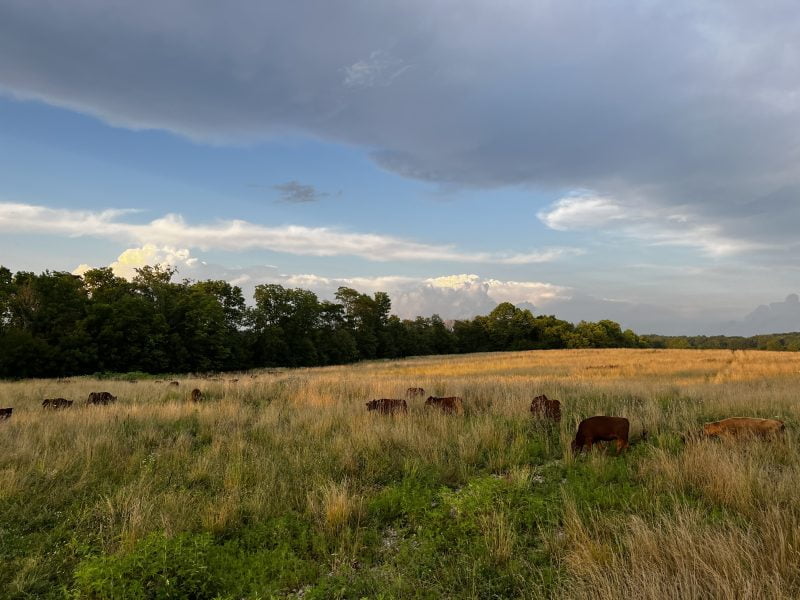 Holistically Managed Cattle in Indiana
Well-managed grazing systems add another layer of benefit. Periodic disturbance from animal trampling and manure deposition can stimulate biological activity and enhance soil carbon sequestration. Research suggests that grazed pastures may have higher methane oxidation rates compared to ungrazed areas, thanks to grazing's influence on soil physical properties and organic matter distribution.
Holistically Managed Cattle in Indiana
Well-managed grazing systems add another layer of benefit. Periodic disturbance from animal trampling and manure deposition can stimulate biological activity and enhance soil carbon sequestration. Research suggests that grazed pastures may have higher methane oxidation rates compared to ungrazed areas, thanks to grazing's influence on soil physical properties and organic matter distribution.
 Regenerative Ground Litter in Indiana
Moreover, holistic regenerative management encourages maintaining a protective layer of organic matter or 'litter' on the soil surface. This layer serves as a natural insulator, buffering the soil from temperature extremes. By blocking direct sunlight, it keeps the soil considerably cooler than the air temperature during warm periods, establishing a more stable and favorable climate for soil microbes, including methanotrophs.
These practices underline the crucial connection between responsible farming, soil health, and broader environmental challenges. By prioritizing water management and maintaining a protective soil cover, holistic regenerative farming supports a thriving soil ecosystem. This ecosystem not only sustains methanotrophs but also plays a significant role in mitigating greenhouse gas emissions.
Regenerative Ground Litter in Indiana
Moreover, holistic regenerative management encourages maintaining a protective layer of organic matter or 'litter' on the soil surface. This layer serves as a natural insulator, buffering the soil from temperature extremes. By blocking direct sunlight, it keeps the soil considerably cooler than the air temperature during warm periods, establishing a more stable and favorable climate for soil microbes, including methanotrophs.
These practices underline the crucial connection between responsible farming, soil health, and broader environmental challenges. By prioritizing water management and maintaining a protective soil cover, holistic regenerative farming supports a thriving soil ecosystem. This ecosystem not only sustains methanotrophs but also plays a significant role in mitigating greenhouse gas emissions.
 Indiana Grassfed Beef promotes a healthy environment
The media and probably the government oversimplify the impact of cattle farming on the environment. It's true that industrialized farming practices can contribute significantly to greenhouse gas emissions and other environmental problems. However, holistic and regenerative cattle farming is a different story.
At Tyner Pond Farm, we are committed to holistic farming practices that enhance soil health, sequester carbon, and reduce methane emissions. Our approach not only respects the environment but also results in healthier, tastier, and more nutrient-rich products.
It's time to challenge the prevailing narrative about cattle farming's impact on the environment. With the right farming practices in place, we can produce beef that's not only delicious but also beneficial for our planet.
Let's change the narrative together. Support holistic cattle farming. Enjoy the taste and respect the earth.
Indiana Grassfed Beef promotes a healthy environment
The media and probably the government oversimplify the impact of cattle farming on the environment. It's true that industrialized farming practices can contribute significantly to greenhouse gas emissions and other environmental problems. However, holistic and regenerative cattle farming is a different story.
At Tyner Pond Farm, we are committed to holistic farming practices that enhance soil health, sequester carbon, and reduce methane emissions. Our approach not only respects the environment but also results in healthier, tastier, and more nutrient-rich products.
It's time to challenge the prevailing narrative about cattle farming's impact on the environment. With the right farming practices in place, we can produce beef that's not only delicious but also beneficial for our planet.
Let's change the narrative together. Support holistic cattle farming. Enjoy the taste and respect the earth.
Methanotrophs: Nature's Methane Consumers
 Colony of bacteria
Let's start by introducing an unsung hero in our fight against cattle methane: methanotrophs. These unique bacteria thrive in soil and consume methane, a potent greenhouse gas. They require specific conditions, including access to oxygen and methane, suitable temperature, and a balanced pH level. Healthy, diverse soil ecosystems are ideal environments for methanotrophs to prosper.
Colony of bacteria
Let's start by introducing an unsung hero in our fight against cattle methane: methanotrophs. These unique bacteria thrive in soil and consume methane, a potent greenhouse gas. They require specific conditions, including access to oxygen and methane, suitable temperature, and a balanced pH level. Healthy, diverse soil ecosystems are ideal environments for methanotrophs to prosper.
Regenerative Practices: Supporting Methanotrophs and Soil Health
Holistic and regenerative agricultural practices focus on improving soil health and biodiversity, carbon sequestration, and weather resilience. Techniques such as managed grazing can enhance soil structure and organic matter content. Holistic Managed Grazing creates favorable conditions for a diverse microbial community, including methanotrophs. Holistically Managed Cattle in Indiana
Well-managed grazing systems add another layer of benefit. Periodic disturbance from animal trampling and manure deposition can stimulate biological activity and enhance soil carbon sequestration. Research suggests that grazed pastures may have higher methane oxidation rates compared to ungrazed areas, thanks to grazing's influence on soil physical properties and organic matter distribution.
Holistically Managed Cattle in Indiana
Well-managed grazing systems add another layer of benefit. Periodic disturbance from animal trampling and manure deposition can stimulate biological activity and enhance soil carbon sequestration. Research suggests that grazed pastures may have higher methane oxidation rates compared to ungrazed areas, thanks to grazing's influence on soil physical properties and organic matter distribution.
Climate Factors and Holistic Regenerative Management: Shaping Conditions for Methanotrophs
Environmental factors, notably temperature and moisture conditions, are key to the activity of methanotrophs. These methane-consuming bacteria generally favor conditions that are moist but not waterlogged, making the balance of water management a vital element in farming. Holistic regenerative management practices can significantly shape these soil conditions, fostering an environment that is ideal for these helpful microorganisms. By emphasizing soil health and structure, these practices enhance the soil's ability to absorb and retain water effectively. This increased water infiltration mitigates the risk of waterlogging and cultivates a soil environment that methanotrophs find conducive. Regenerative Ground Litter in Indiana
Moreover, holistic regenerative management encourages maintaining a protective layer of organic matter or 'litter' on the soil surface. This layer serves as a natural insulator, buffering the soil from temperature extremes. By blocking direct sunlight, it keeps the soil considerably cooler than the air temperature during warm periods, establishing a more stable and favorable climate for soil microbes, including methanotrophs.
These practices underline the crucial connection between responsible farming, soil health, and broader environmental challenges. By prioritizing water management and maintaining a protective soil cover, holistic regenerative farming supports a thriving soil ecosystem. This ecosystem not only sustains methanotrophs but also plays a significant role in mitigating greenhouse gas emissions.
Regenerative Ground Litter in Indiana
Moreover, holistic regenerative management encourages maintaining a protective layer of organic matter or 'litter' on the soil surface. This layer serves as a natural insulator, buffering the soil from temperature extremes. By blocking direct sunlight, it keeps the soil considerably cooler than the air temperature during warm periods, establishing a more stable and favorable climate for soil microbes, including methanotrophs.
These practices underline the crucial connection between responsible farming, soil health, and broader environmental challenges. By prioritizing water management and maintaining a protective soil cover, holistic regenerative farming supports a thriving soil ecosystem. This ecosystem not only sustains methanotrophs but also plays a significant role in mitigating greenhouse gas emissions.
Antibiotics and Methanotrophs: A Delicate Balance
It's common for antibiotics to be used in conventional livestock production, ending up in the soil via manure. This presence can affect soil microbial communities, potentially inhibiting the methane oxidation by methanotrophs. The effects vary, depending on the specific antibiotic and its concentration in the soil. That's why it's crucial for holistic cattle farming to minimize the use of antibiotics, thus supporting the flourishing of methanotrophs and other beneficial soil microbes. (Note: we use zero antibiotics on Tyner pond Farm) Antibiotics can find their way into soil environments through a variety of routes, including manure from antibiotic-treated livestock, wastewater irrigation, and antibiotic-laced feeds used in agriculture. Once present, antibiotics can affect the composition and function of soil microbial communities, including those of methanotrophs.Holistic Cattle Farming: Part of the Solution, Not the Problem
 Indiana Grassfed Beef promotes a healthy environment
The media and probably the government oversimplify the impact of cattle farming on the environment. It's true that industrialized farming practices can contribute significantly to greenhouse gas emissions and other environmental problems. However, holistic and regenerative cattle farming is a different story.
At Tyner Pond Farm, we are committed to holistic farming practices that enhance soil health, sequester carbon, and reduce methane emissions. Our approach not only respects the environment but also results in healthier, tastier, and more nutrient-rich products.
It's time to challenge the prevailing narrative about cattle farming's impact on the environment. With the right farming practices in place, we can produce beef that's not only delicious but also beneficial for our planet.
Let's change the narrative together. Support holistic cattle farming. Enjoy the taste and respect the earth.
Indiana Grassfed Beef promotes a healthy environment
The media and probably the government oversimplify the impact of cattle farming on the environment. It's true that industrialized farming practices can contribute significantly to greenhouse gas emissions and other environmental problems. However, holistic and regenerative cattle farming is a different story.
At Tyner Pond Farm, we are committed to holistic farming practices that enhance soil health, sequester carbon, and reduce methane emissions. Our approach not only respects the environment but also results in healthier, tastier, and more nutrient-rich products.
It's time to challenge the prevailing narrative about cattle farming's impact on the environment. With the right farming practices in place, we can produce beef that's not only delicious but also beneficial for our planet.
Let's change the narrative together. Support holistic cattle farming. Enjoy the taste and respect the earth.
Tags:
Previous post
A Wake-Up Call for Change: Lessons Learned from the Texas Cattle Tragedies
Next post
